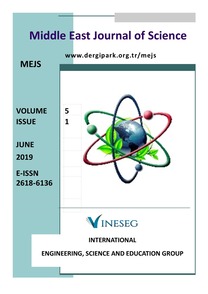DETERMINATION OF SUITABLE RHEOLOGICAL MODEL FOR POLYETHYLENE GLYCOLS AND SILICA PARTICLE MIXTURES
DETERMINATION OF SUITABLE RHEOLOGICAL MODEL FOR POLYETHYLENE GLYCOLS AND SILICA PARTICLE MIXTURES
___
- [1] Hoffman R. L.,“Discontinuous and dilatant viscosity behavior in concentrated suspensions. II. Theory and experimental tests”, J. Colloid Interface Sci., 46(3), 491-506, 1974.
- [2] Bossis G. and Brady J. F., “The rheology of Brownian suspensions,” J. Chem. Phys., 91(3), 1866- 1874, 1989.
- [3] Boersma W. H., Laven J., and Stein H. N., “Viscoelastic properties of concentrated shear-thickening dispersions,” J. Colloid Interface Sci., 149(1), 10-22, 1992.
- [4] Lee B. W., Kim I. J., and Kim C. G., “The influence of the particle size of silica on the ballistic performance of fabrics impregnated with silica colloidal suspension,” J. Compos. Mater., 43(23), 2679-2698, 2009.
- [5] Kalman D. P., Merrill R. L., Wagner N. J., and Wetzel E. D., “Effect of particle hardness on the penetration behavior of fabrics intercalated with dry particles and concentrated particle-fluid suspensions,” ACS Appl. Mater. Interfaces, 1(11), 2602-2012, 2009.
- [6] Baharvandi H. R., Alebooyeh M., Alizadeh M., Heydari M. S., Kordani N. and Khaksari P., “The influences of particle–particle interaction and viscosity of carrier fluid on characteristics of silica and calcium carbonate suspensions-coated Twaron® composite,” J. Exp. Nanosci., 11(7), 550–563, 2016.
- [7] Hasanzadeh M., V. Mottaghitalab, and M. Rezaei, “Rheological and viscoelastic behavior of concentrated colloidal suspensions of silica nanoparticles: A response surface methodology approach,” Adv. Powder Technol., 26(6), 1570–1577, 2015.
- [8] Gürgen S., “An investigation on composite laminates including shear thickening fluid under stab condition,” J. Compos. Mater., 53(8), 1111–1122, 2019.
- [9] Xu Y., “Stabbing Resistance of Soft Ballistic Body Armour Impregnated with Shear Thickening Fluid,” Ph. D. thesis, University of Manchester, Manchester, UK, 2016.
- [10]Chen Q., Liu M., Xuan S., Jiang W., Cao S., and Gong X., “Shear dependent electrical property of conductive shear thickening fluid,” Mater. Des., 121, 92–100, 2017.
- [11]Sun L. L., Xiong D. S., and Xu C. Y., “Application of shear thickening fluid in ultra high molecular weight polyethylene fabric,” J. Appl. Polym. Sci., 129(4), 1922–1928, 2013.
- [12]Ge J., Tan Z., Li W. and Zhang H., “The rheological properties of shear thickening fluid reinforced with SiC nanowires,” Results Phys., 7, 3369–3372, 2017.
- [13]Hasanzadeh M. and Mottaghitalab V., “Tuning of the rheological properties of concentrated silica suspensions using carbon nanotubes,” Rheol. Acta, 55(9), 759–766, 2016.
- [14]Zabet M., Trinh K., Toghiani H., Lacy T. E., Pittman C. U., and Kundu S., “Anisotropic Nanoparticles Contributing to Shear-Thickening Behavior of Fumed Silica Suspensions,” ACS Omega, 2(12), 8877–8887, 2017.
- [15]Rubio-Hernández F. J., Gómez-Merino A. I., Páez-Flor N. M., and Velázquez-Navarro J. F., “On the steady shear behavior of hydrophobic fumed silica suspensions in PPG and PEG of low molecular weight,” Soft Materials, 15(1), 55-63, 2017.
- [16]Santos J., Calero N., Trujillo-Cayado L. A. and Muñoz J., “Development and characterisation of a continuous phase based on a fumed silica and a green surfactant with emulsion applications,” Colloids Surfaces A Physicochem. Engineering Aspects, 555(20), 351-357, 2018.
- [17]Contado C., Ravani L. and Passarella M., “Size characterization by Sedimentation Field Flow Fractionation of silica particles used as food additives,” Anal. Chim. Acta, 788, 183-192, 2013.
- [18]Singh M., Verma S. K., Biswas I. and Mehta R., “Rheology of fumed silica and polyethylene glycol shear thickening suspension with nano-clay as an additive,” Def. Sci. J., 69(4), 402-408, 2019.
- [19]Mawkhlieng U. and Majumdar A., “Designing of hybrid soft body armour using high-performance unidirectional and woven fabrics impregnated with shear thickening fluid,” Compos. Struct., 253, 2020.
- [20]Majumdar A.,. Laha A, Bhattacharjee D., Biswas I. and Verma S., “Soft body armour development by silica particle based shear thickening fluid coated p-aramid fabrics,” J. Text. Inst., 110(10), 1515–1518, 2019.
- [21] Arora S., Majumdar A. and Butola B. S., “Soft armour design by angular stacking of shear thickening fluid impregnated high-performance fabrics for quasi-isotropic ballistic response,” Compos. Struct., 233, 2020.
- [22]Li T. T., Cen X., Peng H., Ren H., Han L., Lou C.W. and Lin J.H., “Rheological response and quasi-static stab resistance of STF/MWCNTs-impregnated aramid fabrics with different textures,” J. Ind. Text., 50(3), 380–397, 2020.
- [23]Zarei M. and Aalaie J., “Application of shear thickening fluids in material development,” J. Mater. Res. Technol., 9(5), 10411–10433, 2020.
- [24]Lin K., Zhou A., Liu H., Liu Y. and Huang C., “Shear thickening fluid damper and its application to vibration mitigation of stay cable,” Structures, 26, 214–223, 2020.
- [25]Gürgen S. and Sofuoğlu M. A., “Vibration attenuation of sandwich structures filled with shear thickening fluids,” Compos. Part B Eng., 186, 2020.
- ISSN: 2618-6136
- Yayın Aralığı: 2
- Başlangıç: 2015
- Yayıncı: -
Alevcan KAPLAN, Umut ÇELİKOĞLU
NEW EXACT SOLUTIONS FOR THE KLEIN-GORDON EQUATION
NEW EXACT SOLUTIONS FOR KLEIN-GORDON EQUATION
Shafi AHMAD, Sedat BİNGÖL, Saif WAKEEL
Cenk YANEN, Ercan AYDOĞMUŞ, MURAT YAVUZ SOLMAZ
A HYBRID MULTI-CRITERIA DECISION MAKING METHOD FOR ROBOT SELECTION IN FLEXIBLE MANUFACTURING SYSTEM
Shafi AHMAD, Sedat BİNGÖL, Saif WAKEEL
COMPARATIVE ASSESSMENT OF DOSE CALIBRATORS USED IN NUCLEAR MEDICINE
Merve CİNOĞLU KARACA, Duygu TUNÇMAN GENÇ, Hatice KOVAN, Mehmet MÜLAZIMOĞLU, Bayram DEMİR
COMPARATIVE ASSESMENT OF DOSE CALIBRATORS USED IN NUCLEAR MEDICINE
Merve CİNOĞLU KARACA, Duygu TUNÇMAN GENÇ, Hatice KOVAN, Mehmet MÜLAZIMOĞLU, Bayram DEMİR
